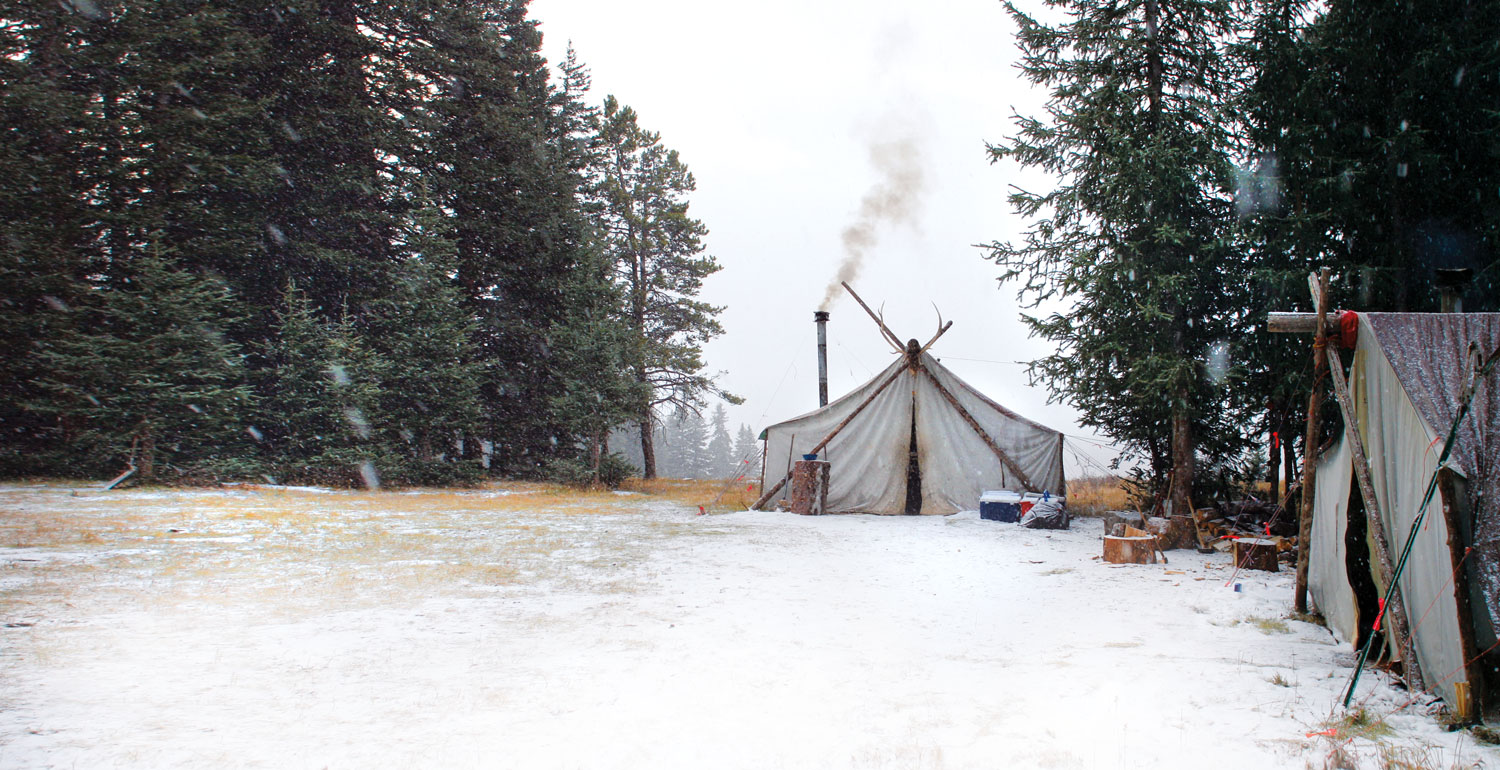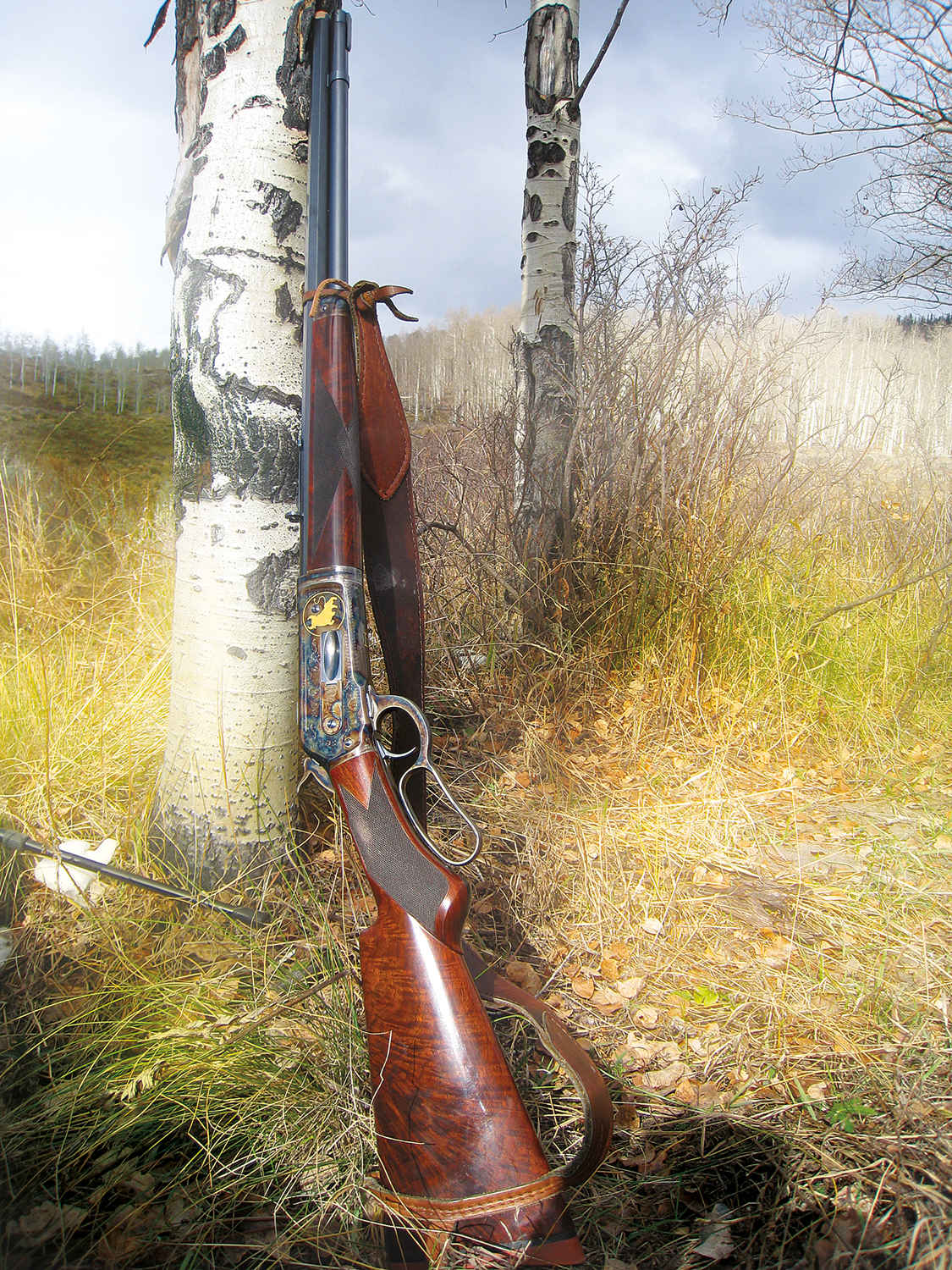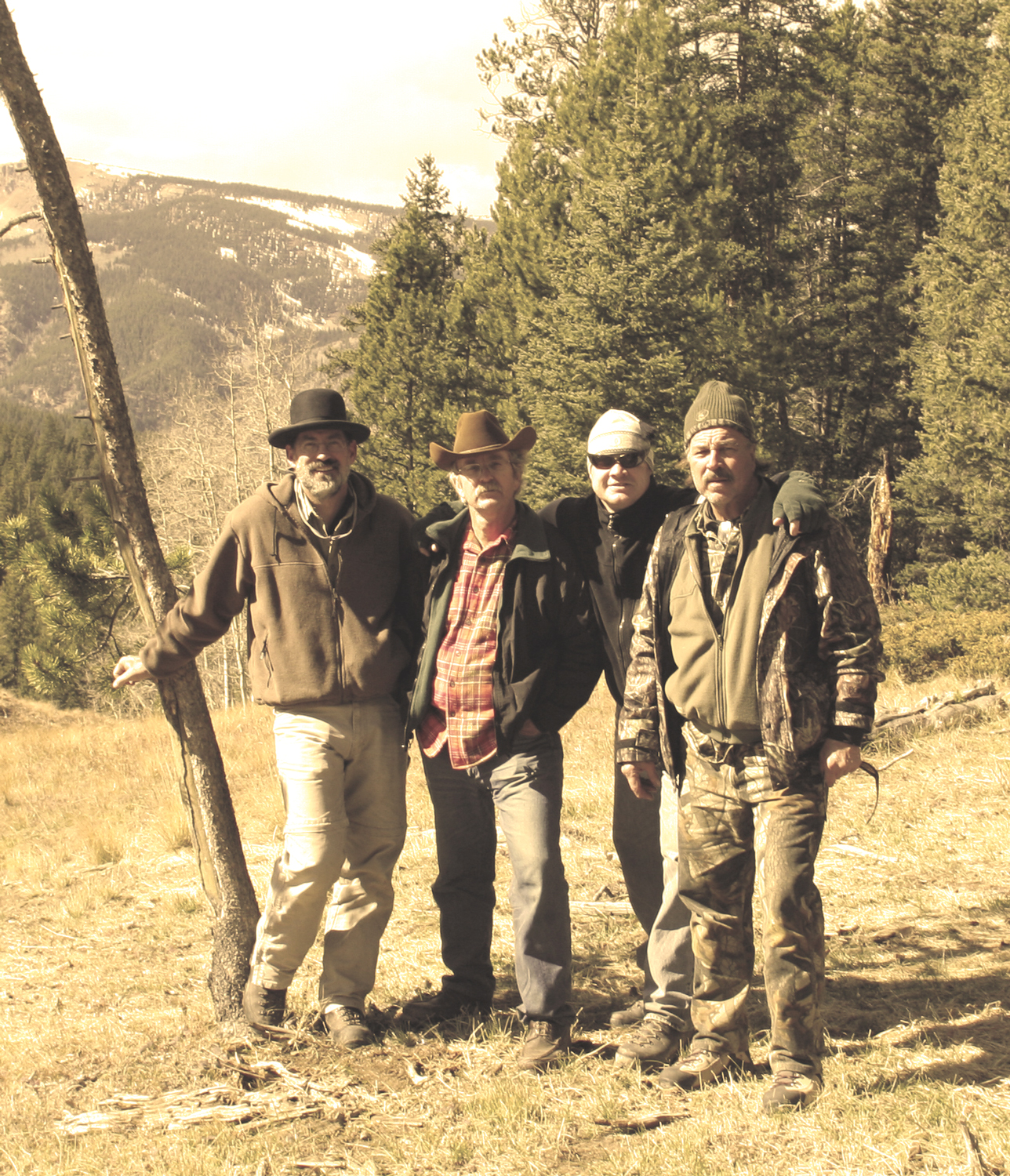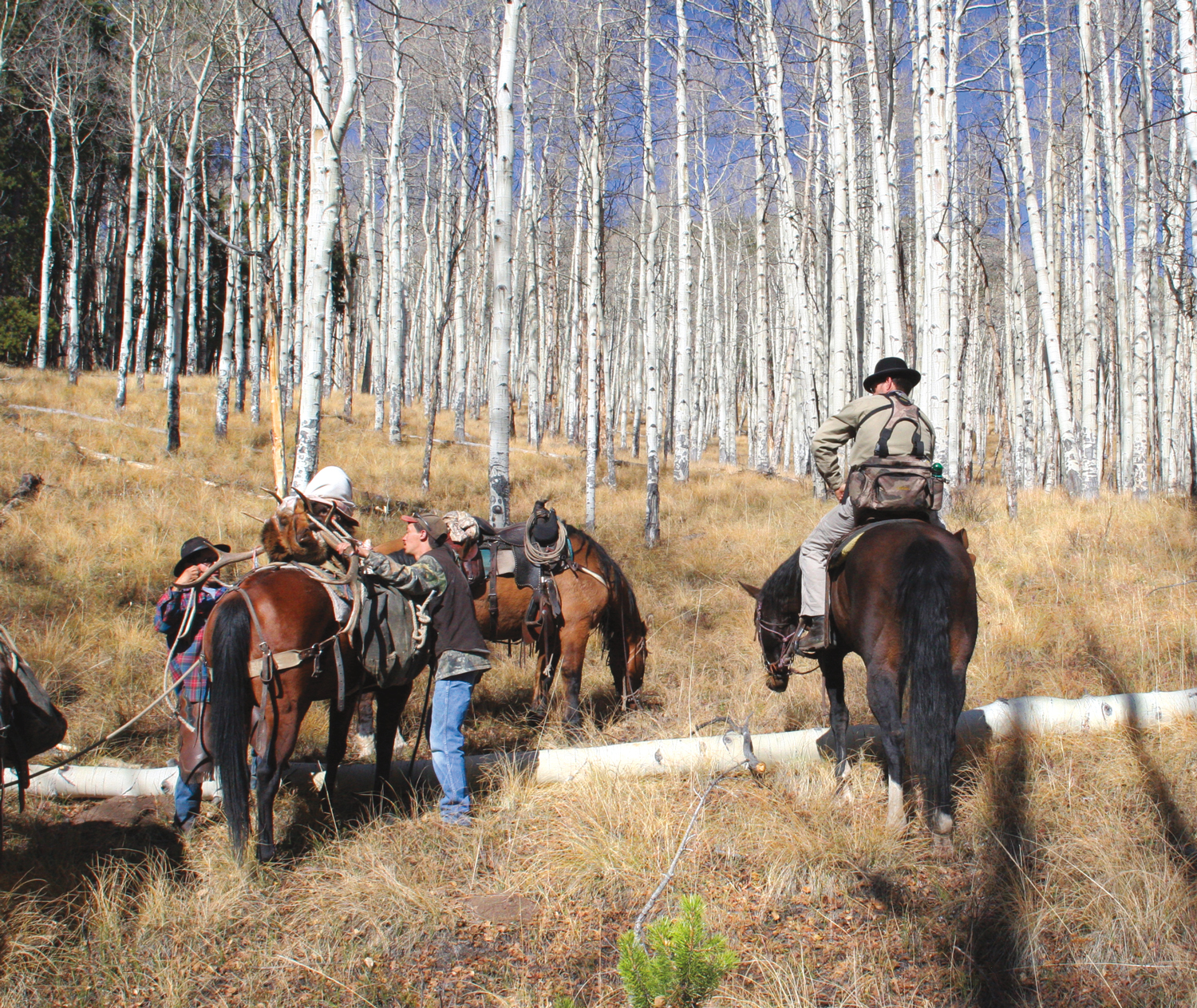The stark shadows of leafless aspens and skeletal-looking lodgepole pines are creeping across the narrow Rocky Mountain canyon and a brisk up-slope breeze is beginning to sharpen its edge a bit as I crouch in the lee of an uprooted Colorado spruce, cradling a lever-action rifle that hums softly of other times and places long, long ago. Although the rifle is one of Doug Turnbull’s magnificent restorations, in my now somewhat wrinkled and age-spotted hands it becomes that old and beat-up Revelation .30-30 shell-shucker that was my first honest-to-gosh deer rifle, a rickety contraption whose stock was held together by rusty baling wire, black electrical tape and a couple of stripped-out brass woodscrews. And my hands are no longer arthritic vestiges that ache in the mornings, but are youthful again: strong, resilient and hot with the pulsing of a young hunter’s blood.
It has been, I reflect, one of the most wonderful days of my life, with enough beauty, enough thrills and enough emotion to last the average person a lifetime. And – oh yes – with just a bit of stark terror thrown in for seasoning.

The day had begun early – 4 a.m. mountain time to be exact – when Doug’s alarm clock began insistently beeping. I had just barely been drifting along on the edge of sleep anyway, so crawling out of the down sleeping bag and staggering zombie-like into my hunting clothes seemed more relief than anything after a night of gasping for oxygen at 10,700 feet high in the Rockies. Dave Mapes, our outfitter with 30-plus years of experience, runs a marvelously organized camp, but even he can’t enrich two-mile-high air.
The frosty grass outside crunched beneath my boots as I made my way to the cook tent where fat pancakes, sinfully greasy sausage links and scalding grounds-rich coffee awaited. In what seemed mere seconds, however, I was saddled up and riding out of camp on Sweet Pea, a sturdy and sure-footed little mountain horse that Dave, our outfitter, kept in reserve for people like me who consider it felonious to use the terms “horseback riding” and “pleasurable” in the same paragraph, who, in fact, equate riding a horse with a visit to the IRS.
I love the gentle animals – don’t get me wrong – but I’m content to put up hay for my wife’s two quarter horses and offer them the occasional treat, leaving the riding to someone else with better equilibrium and más grande pelotas. Like my wife, for instance.
Doug and I are toting lever-actions with open iron sights – rifles that had raised more than a few eyebrows when we carried them into camp, but that also got admiring glances for their rugged beauty and looks of sturdy functionality. Doug, whose company’s motto is “Shoot History,” is one of – if not the – planet’s expert on late 19th century lever guns and the world’s leading restorer and replicator of such classics as Model 1873, 1892 and 1894 Winchesters and Model 1893 and 1894 Marlins as well as classic handguns and smoothbores.

Doug Turnbull personally restored and embellished this original 1886 Winchester, now chambered in .475 Turnbull.
The unspoken consensus among our guides and fellow hunters seems to have been that both Doug and I would be wasting a perfectly good elk hunt by leaving our modern telescope-equipped rifles at home. Everyone knows, of course, that hunting Rocky Mountain elk is an affair of legendary distances that increase with every telling, where powerful riflescopes, barrel-burning seven-league cartridges and even shooting tripods are de rigueur. One might as well bring along a club or flint-tipped spear as an archaic cowboy rifle with metal sights.
Doug and I, of course, begged to differ, though admittedly, at first I would have preferred to be carrying “Ma Bell,” my .338 Remington Ultra-Mag topped with a Leupold scope capable of revealing the rings of Saturn. But Doug had personally invited me on the hunt and had even shipped me one of his magnificent rifles along with enough .475 Turnbull ammo to reacquaint myself with shooting sans-glass. Happily, I had discovered that despite bifocals and doubts about my steadiness, I was soon busting paper prairie dogs at a measured 150 yards, while giving my hayfield a good plowing in the bargain, 400 grains at a time.
The .475 Turnbull topped off with a 400-grain hollow-point is an impressive package. The big slug comes hauling out of the barrel at some 2,150 feet-per-second with a muzzle energy of just over two tons. Where the business payload of a .300 Winchester Magnum might be compared to an F-16 fighter jet, the .475 Turnbull would be best compared to a rocket-assisted D-9 Caterpillar. Despite this, the rifle and cartridge are amazingly mild in the recoil department. Doug claims that it feels about like shooting a 12-gauge slug gun; I think that it better approximates the kick – more of a solid shove actually – of a properly charged .50 caliber inline smokepole.

The hunting party, from left: Gunmaker/restorer Doug Turnbull, author Bob McKinney, and Michigan hunters Ed Popso and Eric Huey.
We were hunting with Ed Popso and his nephew Eric Huey, both from Michigan and both toting .300 Winchester Magnums equipped with scopes. Doug got paired up with Eric, while Ed and I shared Don Lopez, a half-Sioux, half-Spanish guide who maybe weighs a hundred pounds soaking wet, and who turned out to be as fine a guide and human being as any I’ve ever hunted with, notwithstanding his proclaimation that any successful hunter of his had to bite the still-warm heart of his kill.
After about half-a-mile, Doug, Eric and their guide veered off to check out a large open park while Don, Ed and I plunged almost straight down into a long canyon. We were barely out of sight when rifles began blasting behind us. Grumbling that his fellow guide was supposed to have waited until we got into position, Don posted Ed at the periphery of a small park about two miles down the canyon and I found myself hunched beside a big granite boulder overlooking a crossing where the ground was chewed up by elk hooves so that it resembled a Dodge City feedlot.
Neither Ed nor I got a shot that morning; Ed because the bull he spotted kept hanging out too close to his harem of cows and I because I just flat didn’t see an elk of either gender, although I kept hearing plenty of movement in the dark timber above and behind me.
The sun had just transited into afternoon when Don and Dave arrived and suggested that Ed and I saddle up and ride out of our canyon, cross a ridge and try a neighboring canyon where he was sure the elk had gone, possibly a really giant bull that Dave had been seeing off and on for several weeks. Right about then I wasn’t sure that I wouldn’t rather walk out than climb back aboard Sweet Pea, but I swallowed my reservations about equine transportation in hopes of getting a bull.
Thankfully, riding up the steep and rocky trail wasn’t nearly as harrowing as going down, but no sooner had we had topped out on one canyon than we plunged back down another, even steeper and rougher one. My derrière was beginning to cramp up tighter than a miser’s purse, but it was hard not to appreciate the country we were riding through. Signs of elk were everywhere, including shredded saplings and a muddy, smelly and obviously quite popular wallow.
By the time we tied our horses in a small copse of pines, walking on my own two feet had never looked better. Dave and Ed had stopped earlier, about a half-mile up the canyon where they planned still-hunt their way down-slope. Don left me standing beside an uprooted spruce and began angling up a ridge, hoping to scare up something that might cross below me.
He had only been gone about ten minutes when I heard a crashing commotion behind me – elk coming downhill fast! Not where they were supposed to be at all! I spun around and saw a decent bull leading two cows directly toward me at a full gallop. Unprepared for other than the ungodly long shot for which I had practiced, I quickly did the math in my head: The bull had ten antler points, just over the four-by-four legal minimum in Unit 55. My trusty .475 Turnbull came up and fired almost without my having willed it and certainly without sighting. The first slug, a bit high, staggered the bull; the second, a solid lung shot, sent him cartwheeling. The cows vanished faster than the paycheck of a sailor on shore leave.
The distance? Forty-five feet at the outside. I paced it. And after all my practicing at 150 yards. Oh, well.
Dusk was now gathering quickly as I began quartering out my bull. Just before the demise of shooting light, I heard Ed’s rifle clap twice in rapid succession; then, a few seconds later a third, definitive time. He had downed a good six-pointer. It was to be the best bull of the day since Doug, Eric and I had each taken five-pointers.

By the time Don and I had my bull quartered and bagged, it was darker than the inside of an Angus. Fortunately, Don had forgotten about biting elk hearts and I figured it best not to insult his memory by reminding him. We stashed the meat and head beneath a pile of pine boughs to hide them from the ravens and walked to where our horses stood patiently waiting.
When Dave and Ed found their way to us, we mounted for the ride up and out. I’ve done a lot of dicey, plumb-nuts things in my life, but getting onto that cold hard saddle and riding up three miles of Colorado canyon on trails that would make mountain goats consider a career in domestic cheese production put me into testosterone debt for the next ten years. Root canals and meeting my future mother-in-law come to mind as apt comparisons. Suddenly my life seemed in the hands of a creature that didn’t have any.
For a little while a couple of our party weakly lighted the way with those ball caps that have LEDs in the brim, but suddenly Dave, a homespun philosopher and genuine modern day mountain man, declared, “Lights out everybody! Let’s enjoy the stars.”
I figured that I might as well, since in all likelihood they were going to be the last thing I ever enjoyed, but as Sweet Pea plodded steadily along beneath me, I drifted toward the realization that I was not going to die that evening, but was, in fact, right at that moment one of the luckiest human beings on this big blue marble we call home.
There was no moon, but the high mountain air was so clear that the stars twinkling overhead seemed to cast shadows as we rode along through ghostly forests of aspen and the dark shapes of pines and spruce. The mysterious aroma of mountains permeated the up-canyon breeze and somewhere, far away, a coyote howled and another answered. The stars were so beautiful that it was impossible not to marvel at the grandeur of it all.
A long-ago forgotten verse of Home on the Range began to creep its way into my consciousness, faint at first like the tinkling of tiny elfin bells, then louder and stronger until it drowned out all of the apprehensions and fatigue and fear:
Sometimes at night, When the heavens are bright,
With the light of the glittering stars, I sit there amazed,
And ask as I gaze, Are their worlds as wondrous as ours?
IF YOU WANT TO GO
To find out all about Doug Turnbull’s magnificent rifles and his company’s extraordinary restoration services, check out www.turnbullrestoration.com You will find that Doug and his employees are eager to discuss your individual needs, whether they include purchasing a firearm or procuring the loving restoration of a cherished old gun that has been in your family for more than a century.
To book a hunt contact Quaking Aspen Outfitters, Inc., at www.quakingaspenoutfitters.com. Dave offers hunts for elk, deer, and sheep as well as summer packtrips and winter dogsled adventures. Like any reputable outfitter, Dave makes no guarantees, but his hunters routinely get plenty of shots at nice animals, and his outfit is one of the best-run, neatest and most professional I’ve ever seen.
A BRIEF FOOTNOTE
Just for grins, I brought two elk feet home from Colorado with which I embellished a couple of my favorite Virginia whitetail mud holes. Elk prints resemble whitetail tracks close enough to fool the average hunter if carefully applied. Of course, a whitetail with feet of that size would probably weigh in the neighborhood of half-a-ton. In all honesty, I expected someone to call my bluff right away, but no one has so far. However, I have heard of seven local hunters who have sworn to have personally seen what, if ever harvested, could rewrite any number of record books and become the undisputed state record for Virginia whitetails.

